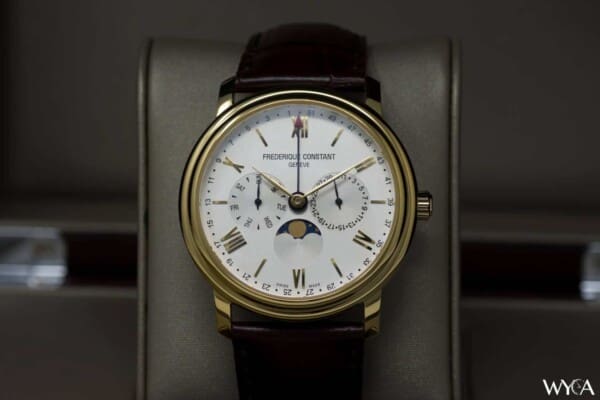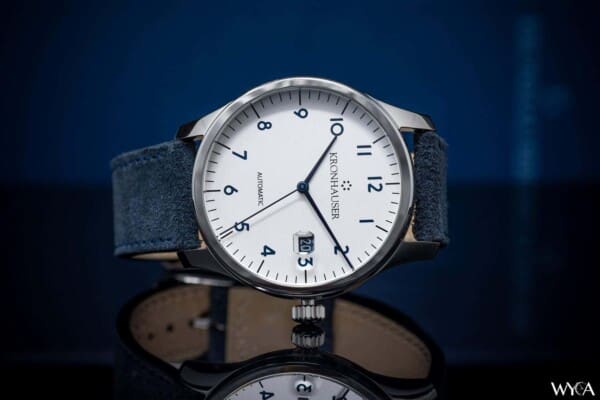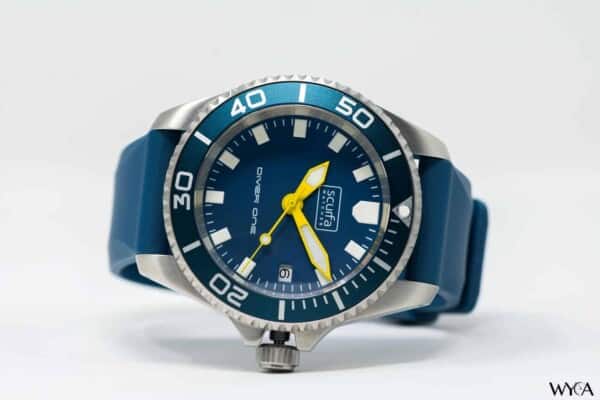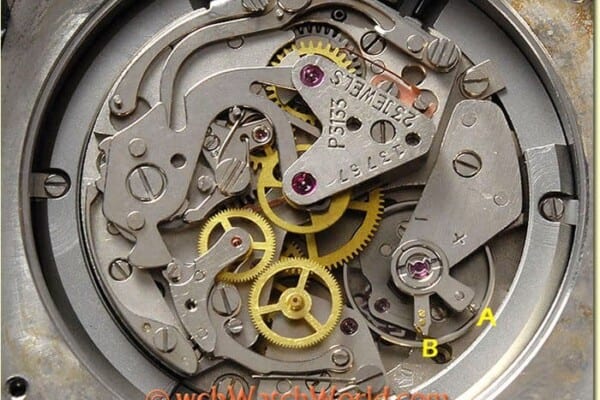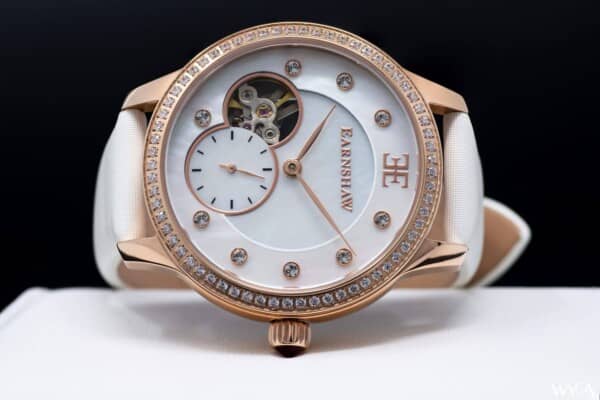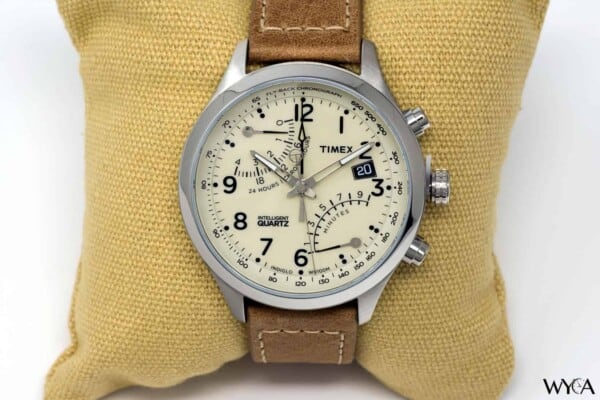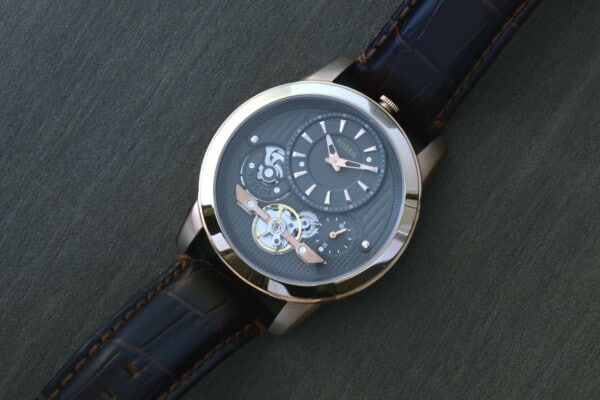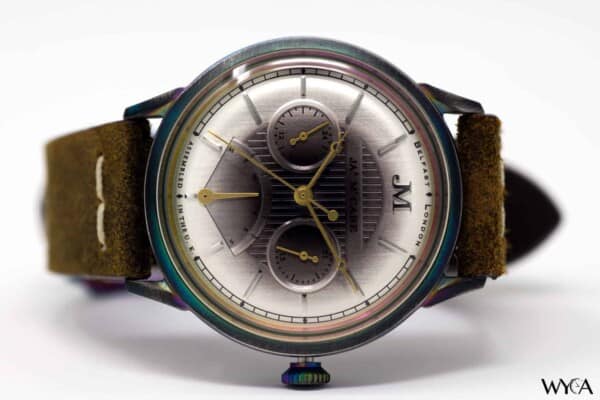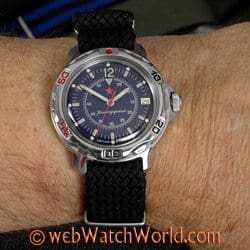Summary: The Casio G-Shock needs no introduction. With millions of G-Shock fans worldwide and hundreds of different designs, shapes and colors to choose from, the G-Shock (and Casio wristwatches in general) are among the most popular in the world. Here’s a brief look at three very different G-Shocks, along with one of the least expensive Casio Waveceptors thrown in for good measure.
Introduction
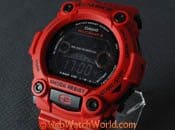 Casio watches and the G-Shock in particular are some of the most ubiquitous wristwatches in the world (see the Casio G-Shock GLX-150 review).
Casio watches and the G-Shock in particular are some of the most ubiquitous wristwatches in the world (see the Casio G-Shock GLX-150 review).
The brand can be found just about anywhere you look; in department stores, discount stores, online (of course) and — yes — even in wristwatch retail shops!
Just about everyone I’ve know or have talked to about wristwatches has owned a Casio at one time or another and often a low-end Casio digital watch will serve as a youngster’s first “serious” timepiece.
Mechanical wristwatch fanciers may scoff at the brand but there’s no denying that Casio has, in their own way, brought an appreciation of timekeeping to the masses and they have also developed a huge cult following for the very popular G-Shock.
Background
 I’ll admit right off that although I definitely appreciate the brand, I’m not a G-Shock or Casio fanatic. These wristwatches serve mostly a utilitarian role for me…albeit with a bit of style.
I’ll admit right off that although I definitely appreciate the brand, I’m not a G-Shock or Casio fanatic. These wristwatches serve mostly a utilitarian role for me…albeit with a bit of style.
That the G-Shock has that rugged, no-nonsense, go-anywhere and do anything aura has much to do with its appeal. In reality — just as it is with 300 meter mechanical dive watches — the vast majority of G-Shock owners probably never use, nor do they need, most of the capabilities inherent in these watches.
But, you probably don’t need 300 horsepower in a car either, or carbon fiber valve covers on your motorcycle. The bottom line is that G-Shocks are cool, they’re different, they make a statement and probably the best part about it is that they’re cheap as chips compared to most mechanical watches.
 This means that when your G-Shock bites the dust (does that ever happen?), you can throw it away and buy a new one without much heartache.
This means that when your G-Shock bites the dust (does that ever happen?), you can throw it away and buy a new one without much heartache.
But that brings up another point. Some collectors become very attached to a particular timepiece, and although I guess it may happen with G-Shock owners also, for the most part I’d guess that the Casio watches are considered more of a functional, tool rather than something that garners a lot of emotion.
Of course, if your Pathfinder saved your life by guiding you out of the woods after a plane crash, I’m sure you’d feel different!
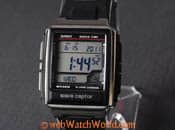 The G-Shock is probably the most identifiable or best-known Casio wristwatch. Said to be first developed in 1983 (the DW-5000C), the G-Shock’s claim to fame is its ability to withstand bumps, bruises and vibes far beyond what would be considered suicide for a mechanical watch.
The G-Shock is probably the most identifiable or best-known Casio wristwatch. Said to be first developed in 1983 (the DW-5000C), the G-Shock’s claim to fame is its ability to withstand bumps, bruises and vibes far beyond what would be considered suicide for a mechanical watch.
What’s curious to me is that although Casio generally states the waterproof ratings of their G-Shock watches, I haven’t seen any specific data on how many “G’s” a G-Shock can withstand over what period of time. In other words, just how shockproof is a G-Shock? Perhaps this information exists somewhere, but I haven’t even come across a discussion of the issue…which also tells me that the watches are more about “show” than “go”.
No problem — it’s the thought that counts, and there are many G-Shock owners who will testify to the ruggedness of this timepiece.
G-Shock Functions and Features
 The G-Shock and other Casio watches have come a long way from their simple beginnings with a basic LCD time and date display. Casio added solar capability (“Tough Solar”) to the G-Shocks and other watches to eliminate battery replacements and then came the “atomic clock” synchronization function. This is included in many Casio watches, including some of the G-Shocks and, of course, the Waveceptor line, so named due to the atomic clock synchronization capabilities.
The G-Shock and other Casio watches have come a long way from their simple beginnings with a basic LCD time and date display. Casio added solar capability (“Tough Solar”) to the G-Shocks and other watches to eliminate battery replacements and then came the “atomic clock” synchronization function. This is included in many Casio watches, including some of the G-Shocks and, of course, the Waveceptor line, so named due to the atomic clock synchronization capabilities.
Each year, Casio releases new G-Shocks in different colors and styles, although the case shapes remain relatively constant, or at least they don’t change as frequently as the case colors. Collectors love this, of course, and there are also many limited edition G-Shock watches released, some with various sponsorships from both commercial and non-commercial organizations.
One other major defining feature of most of the G-Shocks is the numerous digital functions they can perform. It’s rather mind-boggling and my biggest complaint with any of the Casio watches in general is that the menu system and user operability leaves a lot to be desired. Even the simplest watches, such as the Waveceptor WV-59A I’ll describe, have more functions than, oh, let’s say then about 99.99% of their owners will ever use.
 Accessing these functions and remembering how to use them can be a real chore. I personally always feel like I’m not getting everything I can out of the G-Shock watches because I either don’t remember how to use the functionality or I can’t get it to work the way I want when I do — or it takes too long to work my way through the menu system to get it to work correctly.
Accessing these functions and remembering how to use them can be a real chore. I personally always feel like I’m not getting everything I can out of the G-Shock watches because I either don’t remember how to use the functionality or I can’t get it to work the way I want when I do — or it takes too long to work my way through the menu system to get it to work correctly.
You’d think in the year 2011 and with 4 big buttons that they’d be able to design something more intuitive. I’m sure the older you get the less likely you are to have the patience to try and figure out a complicated G-Shock with multiple stopwatches, countdown timers, moon phases, tide charts and more.
That’s about all I know of Casio and the G-Shock phenomenon; I’ll be the first to admit I’m a novice when it comes to these interesting timepieces. The purpose of this article is to simply show off some of the Casio watches I’ve owned or currently own. In the end, I’ll let you know my favorite of this bunch — and I bet you’ll be surprised!
The G-Shock “Mudman” G-9000MX-8
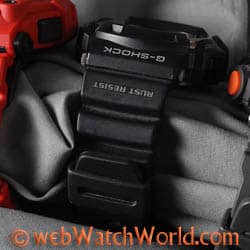 This is one of my most recent G-Shock acquisitions, from the G-Shock “Mudman” series with the special “MX” designation signifying special features supposedly used for FMX (freestyle motocross) and MX (motocross).
This is one of my most recent G-Shock acquisitions, from the G-Shock “Mudman” series with the special “MX” designation signifying special features supposedly used for FMX (freestyle motocross) and MX (motocross).
The Mudman series has its fans and I can see why. It’s a good-looking watch with an easy-to-read display — unlike the “negative” displays of some G-Shocks. I like the styling of the Mudman but it has its detractors, who often cite the faux metal accents seen on either side under the bezel. I happen to think those look very nice and give the watch style and depth.
The Mudman is supposed to be resistant to — you guessed it — mud. How many owners actually need this capability is, well, debatable. When’s the last time you had your hands so deep in mud you were worried about your watch?
The buttons are one of the distinguishing characteristics of the Mudman and they are different than on other G-Shocks. They are covered by thick plastic knurled covers that are set in a removable bezel that fits over the face of the watch. The button covers protect the actual buttons underneath.
 One idiosyncrasy of the Mudman is that the button covers makes the buttons very stiff and difficult to push. Some owners claim that the bezel can be removed and soaked in boiling water to soften up the plastic, while others claim this doesn’t do much. Compared to the “Gulfman” GW-9100 I’ll describe shortly, the buttons on the Mudman are indeed very stiff feeling. The Gulfman buttons are wonderfully smooth and easy to use in comparison.
One idiosyncrasy of the Mudman is that the button covers makes the buttons very stiff and difficult to push. Some owners claim that the bezel can be removed and soaked in boiling water to soften up the plastic, while others claim this doesn’t do much. Compared to the “Gulfman” GW-9100 I’ll describe shortly, the buttons on the Mudman are indeed very stiff feeling. The Gulfman buttons are wonderfully smooth and easy to use in comparison.
I won’t go into the details of operating each of these watches — that takes a careful study of the tiny user’s manuals that are packed in the traditional “tin can” box (and .pdf versions can also be found online).
In addition to its 12/24 time display, the Mudman features two independent stopwatch functions of 1/100-second that can run for up to 1,000 hours for separate timing of two different events simultaneously. How, why and when you’d ever do that is beyond me, but it’s there.
 The G-9000MX-8 shown here is the black/orange version that has a list price of $99.00 USD. It is also currently listed in blue or red on the Casio G-Shock website.
The G-9000MX-8 shown here is the black/orange version that has a list price of $99.00 USD. It is also currently listed in blue or red on the Casio G-Shock website.
Another feature of this watch is the backlighting, which is turned on by pressing the ribbed bar just under the “Shock Resist” type at the traditional 6 o’clock position. It’s a good light that creates a strong contrast at night for viewing the time, but it does take a separate hand to turn it on. I believe this version has tilt function that can be turned on to allow the backlighting to come on when the watch is tilted towards the owner, as if reading the time…but I’m not sure, having never tried to set it.
 I find the Mudman to be very comfortable, but some owners complain about the six raised buttons on the underside. They are supposed to allow moisture to drain from between the watch and the wrist (the watch is claimed water resistant to 200 meters). I don’t notice them and the Mudman feels light and comfortable to me. The wearability is enhanced by the double-clasp strap which, like every Casio watch I have ever owned, is about 25% longer than necessary.
I find the Mudman to be very comfortable, but some owners complain about the six raised buttons on the underside. They are supposed to allow moisture to drain from between the watch and the wrist (the watch is claimed water resistant to 200 meters). I don’t notice them and the Mudman feels light and comfortable to me. The wearability is enhanced by the double-clasp strap which, like every Casio watch I have ever owned, is about 25% longer than necessary.
This particular Mudman does not have the Tough Solar or atomic synchronization features and it runs slightly fast, gaining about 1 second per week. Several other Mudman variants are available, however. The battery on this one has a claimed life expectancy of 3 years. More information is available on the Casio website. I weighed the Mudman at 56 grams (2 oz.) and it’s 45 to 47 mm across and 14.5 mm thick.
The G-Shock GW-7900RD-4CR “G-Rescue” Series
 Here’s another interesting G-Shock; this one comes from the G-Shock “G-Rescue” series with blacked-out trim. This is the “Men in Burning Red” version and I’m not sure what that means but apparently it’s a collectible; I’ve seen these for $250.00 on auction?
Here’s another interesting G-Shock; this one comes from the G-Shock “G-Rescue” series with blacked-out trim. This is the “Men in Burning Red” version and I’m not sure what that means but apparently it’s a collectible; I’ve seen these for $250.00 on auction?
Even at its list price of $150.00, it’s a bit expensive for a G-Shock and for a while it seemed very difficult to find, as the G-Rescue series is apparently popular with collectors, but now examples seem to be readily available.
This one has the Casio Tough Solar power system and it also has the “Multi-Band 6” atomic synchronization function, which I think is also “self-adjusting”; that is, it will know if you are in a different country and will synch with their atomic time broadcasts.
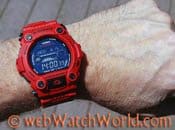 It is also claimed water resistant to 200 meters and it has a tide and moon phase display, along with a countdown timer and an incredible five different alarms that can be set. Again, how, why and when anyone would need five alarms on a watch — especially considering that the alarm buzzer sound is so weak you’d have to be listening for it in a dead silent room to hear it — is beyond me.
It is also claimed water resistant to 200 meters and it has a tide and moon phase display, along with a countdown timer and an incredible five different alarms that can be set. Again, how, why and when anyone would need five alarms on a watch — especially considering that the alarm buzzer sound is so weak you’d have to be listening for it in a dead silent room to hear it — is beyond me.
But, the watch looks cool, no doubt about it, with the blacked-out trim and, unfortunately, the readout. The Casio photos of this watch display are misleading, because this is not an easy watch to read in my opinion. Even pressing the backlight button on the strap at the 6 o’clock position barely lights up the numbers with a dark green light. Only in bright sunshine will the numbers have enough contrast to be fairly easily read.
 The GW-7900RD has completely turned me off to the Casio negative displays and I would never buy another. Too bad, because a GX56 has been calling me…
The GW-7900RD has completely turned me off to the Casio negative displays and I would never buy another. Too bad, because a GX56 has been calling me…
The buttons on this one work smoothly and with a relatively light amount of pressure, unlike the Mudman described above. It also synchs fairly reliably, although it must be located close to a window and be pointed out at night.
This G-Shock weighs 70 grams (2.5 oz.) and it’s a massive 50 mm across and 16.5 mm thick, although the integrated straps and curvature makes all of the G-Shocks much easier to wear than other watches of this size.
The GW-9100 Gulfman
 This is my favorite G-Shock, but not my favorite Casio! I have owned the Gulfman for many years but when I had to wear a dress shirt to work, the Gulfman stayed home because it just doesn’t fit under a dress shirt cuff (nor do any of the G-Shocks described here).
This is my favorite G-Shock, but not my favorite Casio! I have owned the Gulfman for many years but when I had to wear a dress shirt to work, the Gulfman stayed home because it just doesn’t fit under a dress shirt cuff (nor do any of the G-Shocks described here).
So it sat on my dresser, collecting dust — literally! If I place it a meter or so from the window, pointing out at a very particular angle of about 45 degrees to the sky, it will synchronize at night with the atomic clock. But the titanium case on this version of the G-Shock seems to easily block the reception, making this 5-band non-automatic version very difficult to synchronize and probably not a good choice for anyone living in an area of marginal reception.
Otherwise, something about this particular Gulfman speaks to me. That same titanium case is one of the best features of the watch in terms of style; it has that dark gray titanium color peeking out from the sides at 9 and 3 o’clock, giving the watch a tough, macho, military stealth sort of appearance. The semi-matte black resin case is a perfect compliment, as is the green background on the face, which is fairly easy to read as far as G-Shocks go.
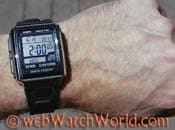 The buttons on this one also work very nicely, with a smooth and precise feel that gives the watch a more expensive sort of countenance.
The buttons on this one also work very nicely, with a smooth and precise feel that gives the watch a more expensive sort of countenance.
Of course, it has a whole host of features I don’t use, such as the countdown timer, five daily alarms or stopwatch with 1,000 hour measuring capacity. Somehow, the functions seem a bit easier to understand and access on this G-Shock, but that is probably my imagination.
The GW-9100 Gulfman is water resistant to 200 meters and the titanium probably helps in that regard (and makes it rust resistant also). This is an expensive G-Shock at a list price of $220.00. I took a chance on it, buying it sight unseen several years ago and I’m glad I did, although I still don’t wear it as much as I should. Summertime and short-sleeved shirts equal G-Shock time for me.
This Gulfman weighs 57 grams (2 oz.) and it’s a little bit top heavy, or rather slightly out of proportion in the width (46 mm) to height (15 mm).
The Casio Waveceptor WV59A-1AV
OK, so it isn’t a G-Shock but this wristwatch is my favorite Casio, believe it or not. It has absolutely none of the rugged tough-guy attitude of even the tamest G-Shock, but it does something that very few other watches do and which interests me very much — it offers a lot of bang for the buck.
The WV59A-1AV is nearly a throw-away watch at a list price of $39.95 and I bought this one for $24.00 several years ago. It has been in the Casio catalog for quite some time but its availability seems to wax and wane, with some online stores listing it and others saying it’s out of stock.
Its rectangular case gives it a sort of geeky look, and I’m OK with that. The value comes from the fact that this watch is a Waveceptor, so it will synchronize to the atomic clock. It’s a one-zone only synch though for the U.S. or the UK only. I can’t remember if you have to manually tell it which clock to synch to or if you have to buy the watch that specifically synchronizes to your country’s atomic clock.
This watch will synchronize almost anywhere; in fact, I leave it buried in my watch box at night and it still synchs without fail. Compare this to other “atomic” Casio watches I have owned, some of which (like the Gulfman) are very fussy about exact positioning before they will synch correctly.
This watch is fun simply because it’s so simple. It’s simplicity is its beauty actually. Unlike the G-Shocks and most of the other over-functional Casio watches, this one has a few basic features that are easy to use.
It has a big, clear, easy-to-read display and the wide expanse of lighter-colored background gives a lot of contrast when the backlight button in the upper right-hand corner is pressed.
This Waveceptor has 29 world time zones, a single stopwatch function that runs up to 60 hours, a countdown timer, a single daily alarm (unfortunately the beeper is very difficult to hear also) and 12/24 hour time display capability. The claimed battery life without solar power is two years, but if you’re in the dark for that long you probably won’t be needing a wristwatch anyway!
The WV59A-1AV weighs a petite 39 grams (1.375 oz.) and, of course, being a Casio, the strap is way longer than you’d ever need. But if wears well at 38 mm wide (button-to-button) and 59 mm long, lug-tip-to-lug-tip. Again, at $39.95, it’s a steal and I hope the seemingly limited availability doesn’t mean this version is being discontinued in favor of the more expensive Casio watches and G-Shocks, which seem to be getting pricier every year.
Conclusion
Casio watches, including the G-Shock line, the Waveceptors and others are amazing technological devices that offer a lot of value. The brand has something for everyone: G-Shock fanatics, mild Casio fans like me and the general public, who cares only for a decent, cheap, reliable wristwatch and for whom digital and/or quartz is the only way to go.
I find it difficult to get over the complexity of the G-Shocks in general and I guess I don’t have the patience to figure out and remember — much less use — all of their features, which look better on paper than in reality. That is one of the things that sort of bothers me about these watches; I don’t like the fact that I’m not getting everything I think I could or should out of the watch.
I also find the larger G-Shocks difficult to wear with any type of long-sleeved shirts, which is probably one of the reasons these watches are so popular with youth, who I suppose aren’t bothered by such constraints.
By the way, only a couple of months ago, a Casio Waveceptor I owned watch failed. It was a WVA430J-1A, which is a three-hand analog/digital display. I never wore it and used it only to set my mechanical watches. It has (or had) solar and atomic capabilities. One day, after it was about 5 years old, it was displaying an incorrect time. I thought perhaps the battery had run down so I set it in the window all day. It never did synch again and eventually just stopped. So I guess the lesson here is that — believe it or not — Casio watches aren’t infallible!
In the end, I keep searching for the “perfect” G-Shock, but that search is no different than my continuing search for the “perfect” mechanical watch; a search that I hope keeps me busily occupied by thinking about wristwatches for a long time to come!f

